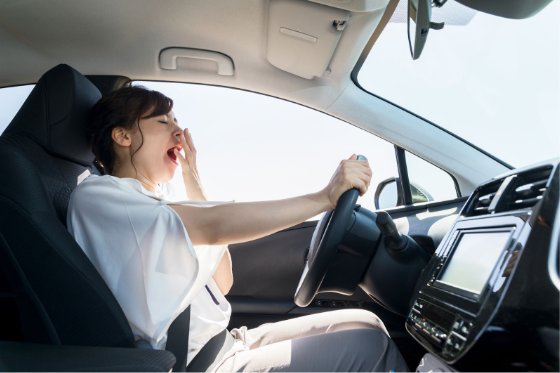In our always-on culture, where sleep often takes a backseat to productivity and social activities, drowsy driving has emerged as a critical public safety issue. Each year, thousands of accidents are attributed to drivers who hit the road when they’re too tired to focus, react, or make good decisions. Understanding the signs of drowsy driving and adopting effective prevention strategies can significantly reduce the risk of accidents and save lives.
Drowsy Driving
Drowsy driving occurs when a person operates a vehicle while feeling fatigued or sleepy. This condition drastically impairs the driver’s ability to react quickly, make sound decisions, and stay aware of their surroundings. One of the most dangerous aspects of drowsy driving is the occurrence of microsleeps—brief, involuntary episodes of sleep that can last from a fraction of a second up to 30 seconds. During this time, a driver can easily veer off the road or collide with another vehicle, with potentially fatal consequences.
The Risks of Drowsy Driving
The National Sleep Foundation reports that more than 6,400 deaths in the United States can be attributed to drowsy driving annually. Furthermore, nearly 10% of all crashes involve a driver who is fatigued, according to AAA. Beyond the immediate danger to life and limb, drowsy driving incidents can lead to increased insurance premiums or even the loss of coverage, not to mention the significant emotional and financial toll on victims and their families.
Signs of Drowsy Driving
Being able to identify when you’re too fatigued to drive is crucial for your safety and the safety of others on the road. Drowsiness can creep up on you, making it difficult to notice until it’s too late. Here are more detailed descriptions of common signs indicating you might be too tired to drive:
- Frequent Yawning: An uncontrollable and repeated act of yawning is one of the first signs your body is trying to tell you it needs rest.
- Heavy Eyelids: When your eyelids feel like they weigh a ton and it’s a struggle to keep your eyes open, it’s a clear indication of fatigue.
- Trouble Focusing: Difficulty in maintaining focus on the road ahead, the speedometer, or traffic signs can significantly impair your driving ability.
- Drifting from Your Lane: Catching yourself unintentionally veering into another lane or onto the shoulder is a dangerous sign of decreased alertness.
- Not Remembering the Last Few Miles Driven: Experiencing lapses in memory where you can’t recall segments of your journey indicates a level of drowsiness that’s unsafe for driving.
Understanding and acknowledging these symptoms as serious red flags are key steps in taking the appropriate actions, such as pulling over to rest, before continuing your journey. This mindfulness can drastically reduce the risk of drowsy driving accidents.
Prevention Strategies for Drowsy Driving
Get Enough Sleep
Ensuring you get at least seven hours of sleep, as recommended by the CDC, is the first line of defense against drowsy driving. A well-rested driver is more alert and makes better decisions.
Check Your Medication
Some medications can induce drowsiness. Always check the side effects of your medications and discuss alternatives with your healthcare provider if necessary.
Be Aware of Medical Conditions
Conditions such as sleep apnea can significantly impair your ability to get restful sleep. Managing these conditions is vital for safe driving.
Avoid Alcohol Before Driving
Alcohol exacerbates drowsiness and impairs your ability to drive safely. Even small amounts can have a significant effect.
Utilize Caffeine Wisely
A cup of coffee or another caffeinated beverage can offer a temporary alertness boost. However, it’s not a substitute for adequate sleep.
Take Regular Breaks
During long trips, stop every couple of hours to stretch and move around. Sharing driving duties can also help prevent fatigue.
Avoid Late Night Driving
The risk of drowsy driving crashes increases during the early morning hours. If possible, avoid driving between midnight and 6 a.m.
Stay Hydrated
Dehydration can lead to fatigue. Drinking plenty of water can help maintain alertness over long distances.
When to Pull Over
If you recognize the signs of drowsy driving in yourself, it’s imperative to pull over to a safe location and rest. Continuing to drive can put you and others at serious risk. A short nap can make a significant difference in your alertness and ability to drive safely.
Conclusion
Drowsy driving is a preventable risk that endangers everyone on the road. By understanding the signs of fatigue and adopting effective prevention strategies, drivers can significantly reduce the likelihood of accidents. Prioritizing sleep, staying informed about the effects of medications and medical conditions, and knowing when to take a break are all critical steps in maintaining safety on the road. Let’s commit to making our roads safer by ensuring we’re always alert and well-rested behind the wheel.
FAQs
Can drowsy driving be as dangerous as drunk driving?
Yes, studies have shown that severe sleep deprivation can impair driving ability as much as, or even more than, being legally drunk. Both conditions significantly reduce reaction times and decision-making abilities.
How can I make my environment less conducive to drowsy driving?
Keep the car’s interior cool and well-ventilated, play stimulating music or podcasts at a moderate volume, and avoid heavy meals before driving, as they can increase drowsiness.
What should I do if I see another driver who appears to be drowsy?
Keep a safe distance from the vehicle and, if possible, notify authorities by calling a non-emergency number to report a potentially impaired driver. Do not attempt to confront or follow the driver.
Get the right coverage for your car with tutenagency
New tutenagency customers?
Quote auto insurance online or call (334) 502-5111 to insure your vehicle.
Disclaimer: This content is for informational purposes only and should not be considered legal or financial advice. Always consult with qualified professionals in legal and financial fields before making any decisions.

